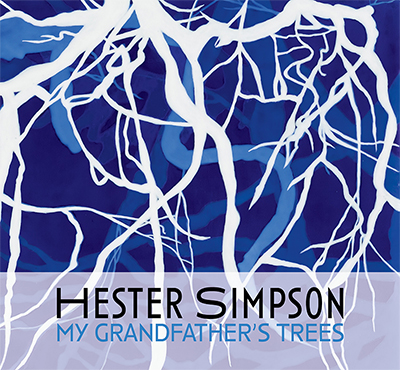Hester Simpson: My Grandfather’s Trees
Mario Naves
Ricco/Maresca Gallery
Published 2024
 Hester Simpson was born in 1949 on Long Island and raised in the town of Locust Valley, where she spent her childhood in the company of her French grandparents, Ida and Jean Schweckler. Steeped in their language, their customs, their frugality, optimism, and love of nature, she developed an early affection for their way of life. Her grandfather, a painter, included her in his many activities in and around the studio. In their War World II Victory Garden, under an enormous apple tree, they gathered beets and rhubarb to boil down into a personal brand of alizarin crimson. Jean Schweckler’s paintings hung throughout the house from both walls and ceilings. The dining room, a mural of rubber-making in Brazil, covered the walls, replete with exotic flora and fauna, cerulean skies, trees and streams. Friends and neighbors regularly gathered for impromptu conversation and a glass of wine.
Hester Simpson was born in 1949 on Long Island and raised in the town of Locust Valley, where she spent her childhood in the company of her French grandparents, Ida and Jean Schweckler. Steeped in their language, their customs, their frugality, optimism, and love of nature, she developed an early affection for their way of life. Her grandfather, a painter, included her in his many activities in and around the studio. In their War World II Victory Garden, under an enormous apple tree, they gathered beets and rhubarb to boil down into a personal brand of alizarin crimson. Jean Schweckler’s paintings hung throughout the house from both walls and ceilings. The dining room, a mural of rubber-making in Brazil, covered the walls, replete with exotic flora and fauna, cerulean skies, trees and streams. Friends and neighbors regularly gathered for impromptu conversation and a glass of wine.
Today, decades after his passing, Simpson credits her grandfather’s spirit with her own passion for her painting practice. My Grandfather’s Trees honors the profound connection she maintains with her childhood in Locust Valley. In the wake of her mother’s passing, she walks through Central Park to her studio and the trees “speak” to her. She snaps a photo, and for the first time uses photography to enlist their exact form as an expression of her present grief, as well as an homage to life. Trees, it seems, contain souls within; her family hidden in plain sight, here and now. Moving from her previous geometric abstraction, Simpson now employs a new vocabulary of arboreal forms. She works slowly and deliberately, layering intense color in acrylic paint, alternating between pouring and brushing, a technique she developed in the late 1990s. The result is an examination of biomorphic pattern with a nod to the preternatural, a quality that both reflects and affirms her premise of regeneration.
